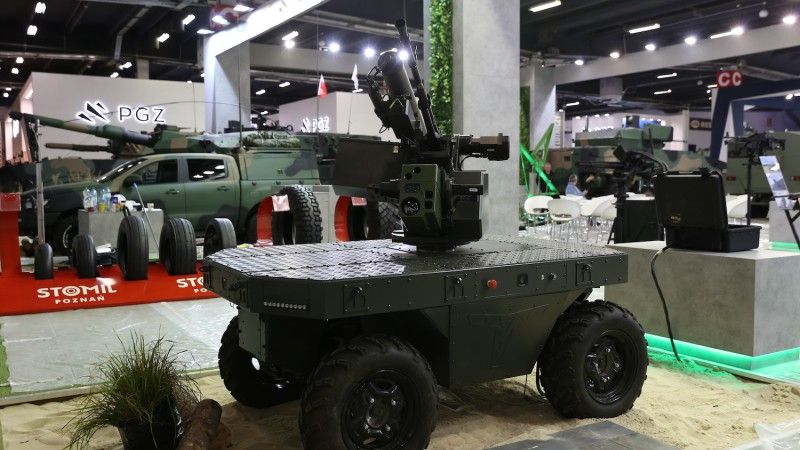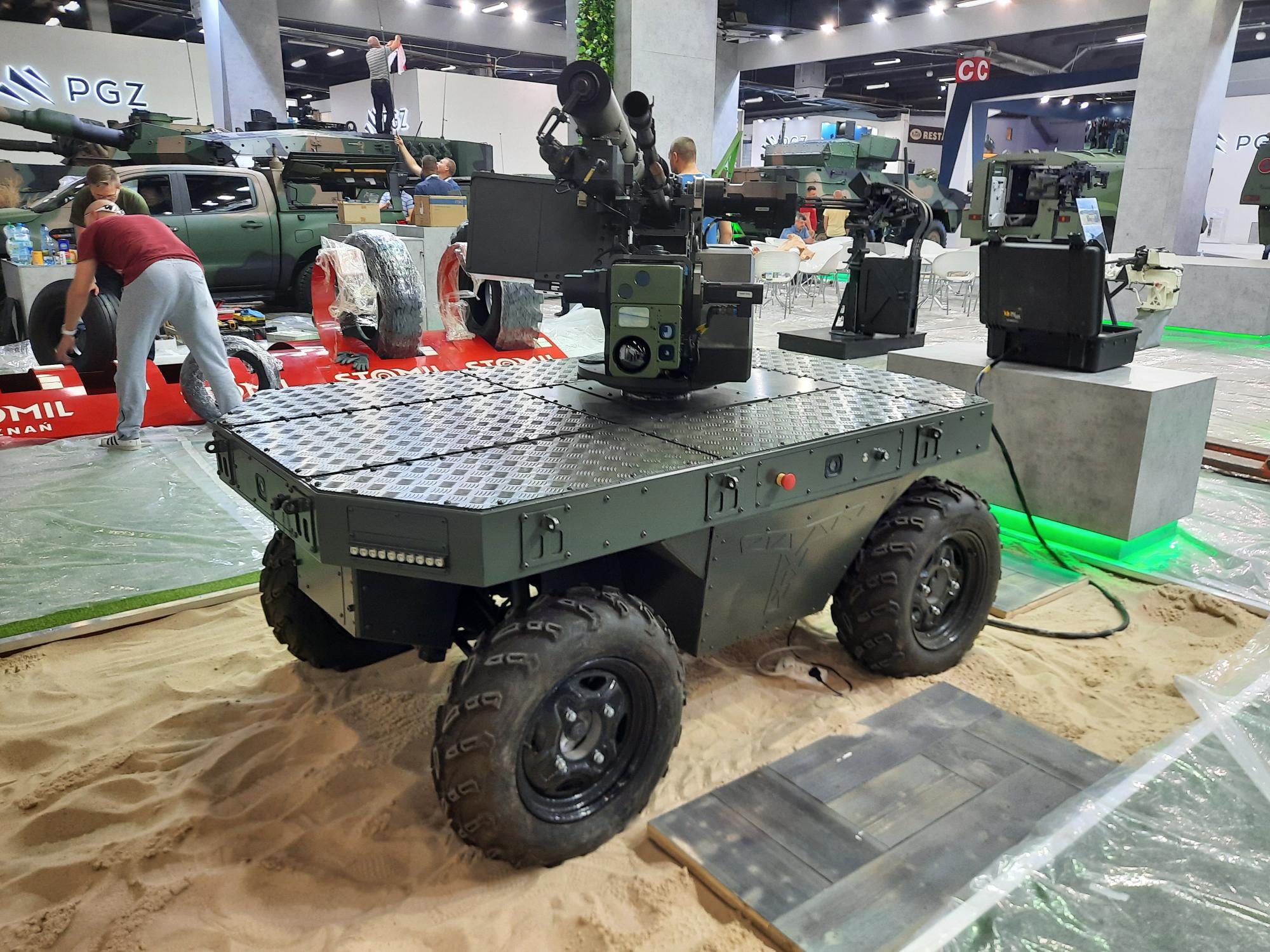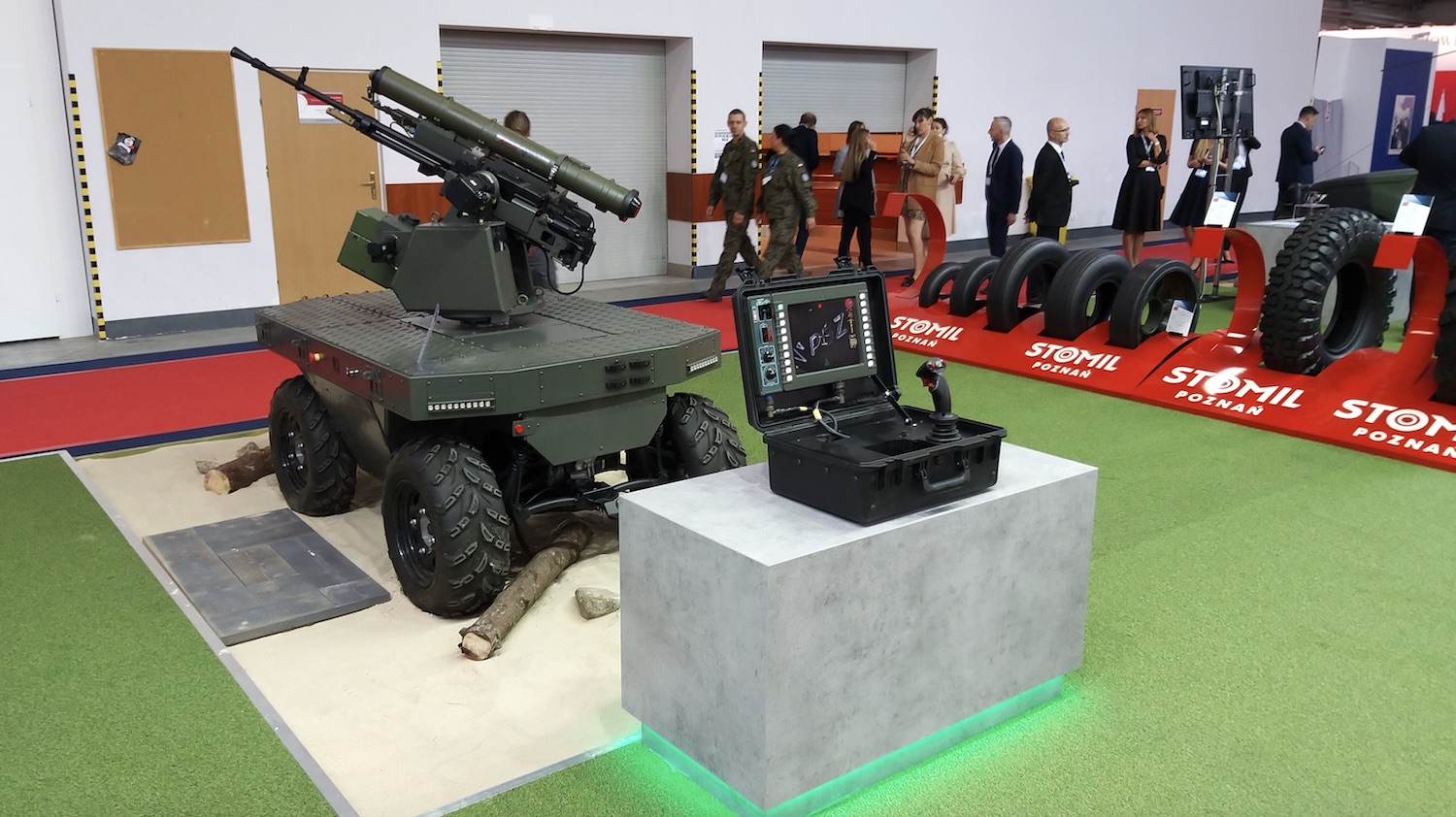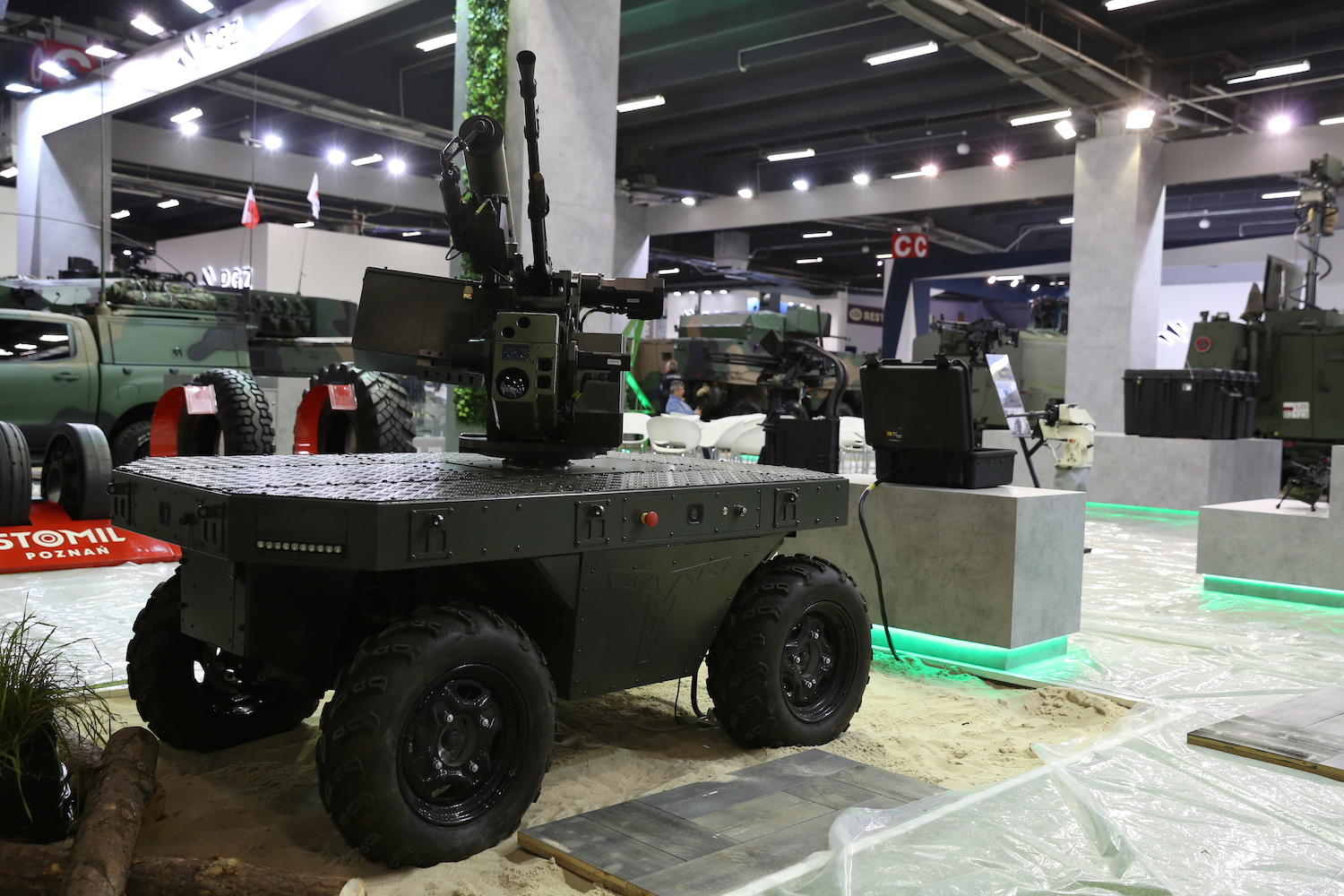Pirat ATGM On Vehicles And Robots

Demonstrator of the Pirat ATGM launcher integrated on a remote control weapons station (Zdalnie Sterowany Moduł Uzbrojenia, ZSMU) has been premiered for the first time, during this year’s edition of the MSPO event. Not only would this solution make it possible to launch ATGMs from light manned and unmanned vehicles, but it would also allow for guiding laser-guided munitions - such as the APR munitions offered by the Polish industry, or Paveway bombs, carried by the F-16s.
Even though "Pirat" ATGM has been originally developed as an infantry weapon, since the very start it was known that the system exhibits major potential for use in other applications. Pirat is a light, laser-guided ATGM, that can act against threats at a range of up to 2.5 kilometers. Noteworthy, not only is it a "direct attack" capable missile, as it can also neutralize targets via a "top attack" engagement - which makes it a potent weapon when used against the heaviest armour, MBTs included.
The CRW Telesystem-Mesko company responsible for the guidance systems and CLU of the Pirat ATGM has developed, working with the PGZ Group's ZM Tarnów, a concept of a weapons station that would make it possible to launch the Pirat ATGMs and guide the Pirat ATGMs and other laser-guided munitions (side note: Mesko company, not CRW Telesystem-Mesko, is the primary contractor in the Pirat ATGM project). To achieve that objective, ZSMU A3B remote control weapons station has been customized. This system, in a standard variant, is armed with a .50-cal. machine gun. The enhanced version also features the LPD-A laser target designator.
The representatives of the Telesystem-Mesko company note that the final form of the system could evolve. ZSMU presented in Kielce features the standard ZMO-1 system with a TV camera, thermal imager, and laser rangefinder. LPD-A designator mock-up would be placed alongside. Ultimately, the plan is to develop a system that would fuse observation sensors and a laser target designator, within a single housing.

A system as such, along with the ATGM and the launcher, would not weigh much more than the A3B version: the weight is expected to be around 200 kilograms. It may be then installed on the very same platforms, as the standard ZSMU. These platforms include 4x4 vehicles, such as the ones offered in the Pegaz procurement, but also unmanned systems. Using the Pirat system for ZSMU integration may mean that new capabilities are acquired at a relatively low cost. In that way, reconnaissance platforms would obtain the anti-tank capability. The same would apply to security units' vehicles, command vehicles, or engineering element vehicles/ARVs. Having a closer look at what the leading NATO member states are doing, vehicles listed above usually feature the light weapons stations, as opposed to heavier turrets that feature 30 mm cannons.
Adding an ATGM launcher to a module as such also has the advantage of utilizing the existing fire control system. A module as such may be used both for neutralization of non-armoured targets and infantry (using the heavy machine gun), as well as for attacking vehicles, including the heavy armour. The latter capability is available thanks to the Pirat ATGM's "top-attack" capability.
One should note that a trend of integration on ATGMs on lighter platforms could have been observed globally, over the recent years. Even though 1 to 2 decades ago the ATGMs were usually fitted onto IFVs (including the wheeled ones), or special purpose platforms designed as ATGM carriers, the miniaturization these days makes it possible to utilize the anti-tank measures as such to a much broader extent.
The US Army is a good example here - as the Americans decided to integrate the Javelin ATGMs with the Kongsberg weapons stations on the Stryker APCs that had been armed only with machine guns/AGLs in the past. Modules as such are reportedly integrated on lighter platforms as well: this refers to the RCV-L robots. Denmark, meanwhile, decided to integrate the Spike-LR2 ATGM on Kongsberg Protector turrets, installed on Piranha 5 APCs and Eagle 5 multi-purpose vehicles.

Russia is also taking relevant steps to improve its potency in this domain. For instance, BMP-2 IFVs, and BMD-2 vehicles operated by the airborne units, by default outfitted only with the obsolete Konkurs ATGM launchers, these days feature four Kornet ATGM launchers. Kornet ATGM is a beam-rider missile. ATGM launchers are also installed on unmanned land platforms, such as Uran-9, or Marker. The above means that even the lighter vehicles may pose danger for armored assets. This is especially important, as one should have assets at one’s disposal, to effectively diminish the anti-tank capabilities available to the adversary. Pirat is partially meeting that requirement. As a light, and relatively cheap ATGM it is a good solution to the problem of acting against enemy main battle tanks and lighter vehicles, with a good cost-effect ratio.
The Polish system is also NATO compliant, with other laser guidance solutions and designators. This means that any weapons station integrated with this system may be used for fire control purposes, in sync with the Pirat ATGM. NATO-compliant laser target designators are also suitable to provide guidance data to launched Pirat ATGMs (from portable, or self-propelled launchers). Any other laser-guided ordnance, compliant with the NATO standards, may be guided in this way. The munitions that can benefit from these capabilities include the 155 mm APR 155 PGM (Precision Guided Munitions) for the Krab and Kryl howitzers, and APR 120 Precision Guided Rounds used with the Rak mortars. The inventory also includes weapons carried by the F-16 MRCA and other NATO aircraft (Paveway bombs), or MAM-L and MAM-C gliding munitions, deployed with the Bayraktar TB2 drones.
Thanks to the above, a turret fitted with the Pirat's guidance system can be used to designate targets for a broad arsenal of weapons, provided that the carrier platform also has a relevant communications system and C2 suite at its disposal. This provides the user with a great degree of flexibility. One does not have to launch the Pirat missile in each case of engagement (and thus disclose its location). The operator also has heavier munitions at his disposal - should the given operational context require the employment of heavier firepower.
The scope of uses that the Pirat-outfitted modules could have is quite broad. Thanks to the compact size and low weight of the system, not only may they be installed on fighting vehicles, but also on support vehicles (ARVs, engineering, reconnaissance platforms), or lighter 4x4 vehicles. This would provide a broader range of platforms with an ability to effectively fight armor and designate targets for artillery and CAS assets.
Vehicles outfitted with ZSMU may then effectively increase the firepower of recon elements, or security elements protecting important components of the defence system - such as the Wisła air defence system. Undoubtedly, assets as such may be exposed to operations undertaken by the enemy recon/special/airborne elements, also operating vehicular platforms. The module could also be installed on stationary infrastructure, such as the LOOK container if systems as such become a part of the inventory of airbases for instance.

ZSMU module integrated with Pirat and a target designator may be integrated on unmanned land platforms as well. This makes it possible to deploy assets as such in areas that are disputed. They would act as forward operating ATGM launchers, without exposing the troops to the potential threats. The module would still retain all of its functions (the use of machine gun, ATGM, but also observation/target designation capacity). One may go even a step further, forming squads of a carrier platform (manned one), that would transport the robot, with both platforms utilizing the very same weapons station.
Integration of the ZSMU system with an ATGM creates a whole spectrum of new options, within the scope of introduction of a cost-effective anti-tank asset that would also be capable of designating targets for PGMs, and with the technology being completely controlled by the domestic industry. A system as such could create a capability to carry out scattered, distributed defence operations that could also involve fighting assets for which the anti-tank operations are not the primary task, as well as unmanned assets. Mesko (manufacturer of the Pirat missile), PCO S.A., or ZM ZM Tarnów could also get involved in the project, alongside Telesystem. The implementation would serve as an impulse and inspiration for further industrial development.
The system offered is a scalable one. It could be further developed, for instance through the integration of a heavier ATGM of longer range and penetration performance, meeting the Ottokar-Brzoza programme requirements. This would require the launcher to be redesigned, and reinforced (the same goes for the missile). Nonetheless, the basic conceptual assumptions, as well as the electronics, would stay the same. Launchers as such could be integrated on both manned, and unmanned platforms, similarly to the ZSMU weapon stations. A system as such could be controlled by all assets carrying laser target designators, including the portable Pirat ATGM launchers, and other weapons stations featuring the said launcher and guidance module.
